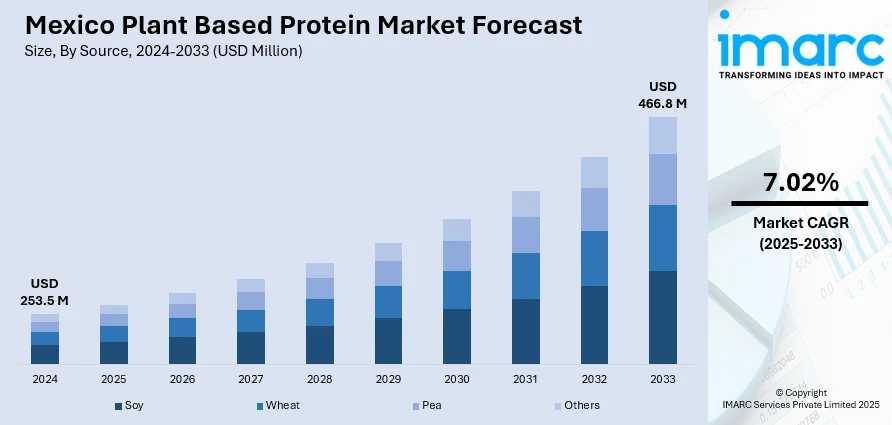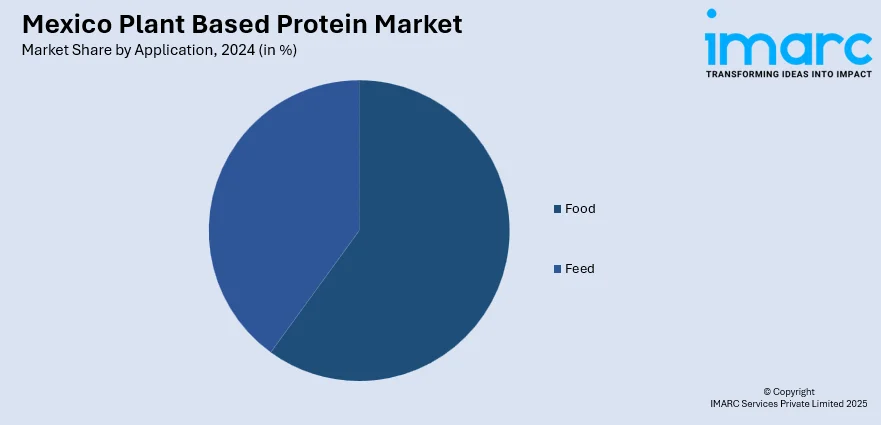
Mexico Plant Based Protein Market Size, Share, Trends and Forecast by Source, Type, Nature, Application, and Region, 2025-2033
Mexico Plant Based Protein Market Overview:
The Mexico plant based protein market size reached USD 253.5 Million in 2024. Looking forward, IMARC Group expects the market to reach USD 466.8 Million by 2033, exhibiting a growth rate (CAGR) of 7.02% during 2025-2033. The market is experiencing steady growth due to shifting consumer preferences toward healthier and more sustainable diets. Growth is supported by rising awareness about environmental impacts, innovations in food technology, and increasing availability of alternative protein products. Retail and foodservice sectors are embracing this trend, boosting the visibility and contributing to the Mexico plant based protein market share.
|
Report Attribute
|
Key Statistics
|
|---|---|
|
Base Year
|
2024 |
|
Forecast Years
|
2025-2033
|
|
Historical Years
|
2019-2024
|
| Market Size in 2024 | USD 253.5 Million |
| Market Forecast in 2033 | USD 466.8 Million |
| Market Growth Rate 2025-2033 | 7.02% |
Mexico Plant Based Protein Market Trends:
Growing Health Consciousness and Dietary Shifts
As consumers become more health-conscious, there is a noticeable shift toward plant-based diets because of concerns about cholesterol, weight management, and overall health. Improvements continue to rise among Mexican consumers who desire protein options that consist of reduced saturated fats and additional nutritional content. Plant-derived proteins obtained from peas and rice, and soy serve as appealing choices for people who wish to decrease their meat consumption. The widespread adoption of veganism, together with vegetarianism and flexitarian dietary patterns, fuels the rise in plant-based protein usage in Mexican food products. The market is benefiting from rising demand for plant-based proteins because these proteins improve digestion and facilitate weight loss, and reduce the risk of chronic diseases.

To get more information of this market, Request Sample
Environmental Awareness and Sustainability
Concerns about the environmental impact of animal agriculture have increased awareness around the need for sustainable protein sources. Plant-based proteins need lower amounts of natural resources such as water and land, during production while releasing less greenhouse gases than traditional animal-based proteins. More Mexican consumers choose vegan alternatives as environmental issues, including climate change along with deforestation, and water scarcity, have gained greater public attention. The growing demand for plant-based protein products in Mexico gets stronger support from global and domestic sustainability efforts, which are emerging simultaneously. The trend is not only growing among individual consumers but also among companies and food brands that focus on sustainability.
Increasing Product Innovation and Availability
The Mexico plant based protein market growth has witnessed a surge in product innovation, driven by advancements in food technology. Companies are creating a wide range of plant-based protein products that closely mimic the texture and taste of traditional meat, such as plant-based burgers, sausages, and dairy alternatives. This innovation is expanding the appeal of plant-based protein to a broader demographic, including those who are not fully committed to plant-based diets but are interested in trying meat alternatives. Additionally, the increasing availability of these products in supermarkets, restaurants, and fast-food chains makes them more accessible to the general public, further driving market growth.
Mexico Plant Based Protein Market Segmentation:
IMARC Group provides an analysis of the key trends in each segment of the market, along with forecasts at the country and regional levels for 2025-2033. Our report has categorized the market based on source, type, nature, and application.
Source Insights:
- Soy
- Wheat
- Pea
- Others
The report has provided a detailed breakup and analysis of the market based on the source. This includes soy, wheat, pea, and others.
Type Insights:
- Concentrates
- Isolates
- Textured
A detailed breakup and analysis of the market based on the type have also been provided in the report. This includes concentrates, isolates, and textured.
Nature Insights:
- Conventional
- Organic
A detailed breakup and analysis of the market based on nature have also been provided in the report. This includes conventional and organic.
Application Insights:

- Food
- Meat Alternatives
- Dairy Alternatives
- Bakery Products
- Performance Nutrition
- Convenience Foods
- Others
- Feed
A detailed breakup and analysis of the market based on the application have also been provided in the report. This includes food (meat alternatives, dairy alternatives, bakery products, performance nutrition, convenience foods, and others) and feed.
Regional Insights:
- Northern Mexico
- Central Mexico
- Southern Mexico
- Others
The report has also provided a comprehensive analysis of all the major regional markets, which include Northern Mexico, Central Mexico, Southern Mexico, and others.
Competitive Landscape:
The market research report has also provided a comprehensive analysis of the competitive landscape. Competitive analysis such as market structure, key player positioning, top winning strategies, competitive dashboard, and company evaluation quadrant has been covered in the report. Also, detailed profiles of all major companies have been provided.
Mexico Plant Based Protein Market News:
- In December 2023, the future of protein venture capital firm Lever VC raised its ownership share in Birdman, a prominent plant-based protein company in Mexico that plans to enter the US, as the business sees a sharp growth in sales. Despite a difficult economic climate, Birdman has demonstrated a remarkable sales performance, establishing a $65 million sales run rate, which has led to this investment.
- In August 2023, Propel Foods, a Mexican firm that uses artificial intelligence (AI) to produce plant-based and hybrid proteins, made its first foray into Mexican retail establishments. Previously exclusively accessible through the brand's online store, the V-Label certified meat substitutes Bistec (steak), Pastor (grilled pork), and Chorizo are stated to be perfect for use in Mexican meals like tacos.
Mexico Plant Based Protein Market Report Coverage:
| Report Features | Details |
|---|---|
| Base Year of the Analysis | 2024 |
| Historical Period | 2019-2024 |
| Forecast Period | 2025-2033 |
| Units | Million USD |
| Scope of the Report |
Exploration of Historical Trends and Market Outlook, Industry Catalysts and Challenges, Segment-Wise Historical and Future Market Assessment:
|
| Sources Covered | Soy, Wheat, Pea, Others |
| Types Covered | Concentrates, Isolates, Textured |
| Natures Covered | Conventional, Organic |
| Applications Covered |
|
| Regions Covered | Northern Mexico, Central Mexico, Southern Mexico, Others |
| Customization Scope | 10% Free Customization |
| Post-Sale Analyst Support | 10-12 Weeks |
| Delivery Format | PDF and Excel through Email (We can also provide the editable version of the report in PPT/Word format on special request) |
Key Questions Answered in This Report:
- How has the Mexico plant based protein market performed so far and how will it perform in the coming years?
- What is the breakup of the Mexico plant based protein market on the basis of source?
- What is the breakup of the Mexico plant based protein market on the basis of type?
- What is the breakup of the Mexico plant based protein market on the basis of nature?
- What is the breakup of the Mexico plant based protein market on the basis of application?
- What is the breakup of the Mexico plant based protein market on the basis of region?
- What are the various stages in the value chain of the Mexico plant based protein market?
- What are the key driving factors and challenges in the Mexico plant based protein market?
- What is the structure of the Mexico plant based protein market and who are the key players?
- What is the degree of competition in the Mexico plant based protein market?
Key Benefits for Stakeholders:
- IMARC’s industry report offers a comprehensive quantitative analysis of various market segments, historical and current market trends, market forecasts, and dynamics of the Mexico plant based protein market from 2019-2033.
- The research report provides the latest information on the market drivers, challenges, and opportunities in the Mexico plant based protein market.
- Porter's five forces analysis assist stakeholders in assessing the impact of new entrants, competitive rivalry, supplier power, buyer power, and the threat of substitution. It helps stakeholders to analyze the level of competition within the Mexico plant based protein industry and its attractiveness.
- Competitive landscape allows stakeholders to understand their competitive environment and provides an insight into the current positions of key players in the market.
Need more help?
- Speak to our experienced analysts for insights on the current market scenarios.
- Include additional segments and countries to customize the report as per your requirement.
- Gain an unparalleled competitive advantage in your domain by understanding how to utilize the report and positively impacting your operations and revenue.
- For further assistance, please connect with our analysts.
 Request Customization
Request Customization
 Speak to an Analyst
Speak to an Analyst
 Request Brochure
Request Brochure
 Inquire Before Buying
Inquire Before Buying




.webp)




.webp)












